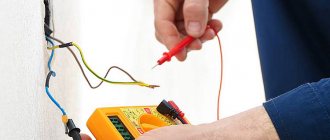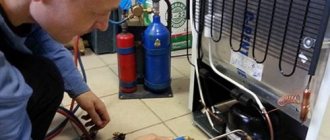If you are faced with a situation where the electricity in the apartment goes out, but at the same time, only half of the apartment remains without light - one room or utility rooms, it is worth understanding the situation and the reasons in more detail. The problem with de-energizing half of the apartment occurs in old houses where the wiring has not been replaced and its wiring from the panel in the entrance has not changed. The fact is that in some cases, current was supplied to the apartment through two lines in order to reduce the load on the line and prevent failure of the wiring when the load increased. In the panel, each line has a separate plug or emergency circuit breaker, which allows you to break or restore the electrical circuit.
A similar scheme is found in houses of different designs, four, five and nine storeys. Usually, at such facilities, if major planned repairs are carried out, then the plugs are simply replaced with modern machines that are reliable and easy to operate. When there is a power outage, you should pay attention to the machines; if one of them is knocked out and the switch is facing down, it is turned back on.
The cause of knockout is poor contact in the circuit, especially in areas where powerful equipment is connected. If the situation repeats, you need to check the sockets, terminal boxes with twists and other connection points for their reliability and the possibility of areas with an oxidized surface appearing. If you find an unreliable connection, it should be redone.
There is no electricity in half the apartment, the machines are on
If the switches are turned on after a power outage, the cause of the malfunction may be as follows:
- The contact in one of the junction boxes with the twists or terminals of the electrical wires is broken;
- The machine itself is faulty (the problem is rare);
- The wiring has broken - this happens during repairs when a tool breaks through the inside of the wiring.
Usually, the problem lies in the junction box and oxidized contacts. Check their integrity and, if necessary, redo the twisting. If the work is carried out independently, then first turn off the electricity supply circuit breakers in the apartment and begin work only after that. The best solution would be to immediately contact a technician who will determine the causes of the malfunction, eliminate it, diagnose the problem and carry out work to prevent repeated breakdowns.
Need an electrician's help? Call
If you are faced with a situation where the electricity in the apartment goes out, but at the same time, only half of the apartment remains without light - one room or utility rooms, it is worth understanding the situation and the reasons in more detail. The problem with de-energizing half of the apartment occurs in old houses where the wiring has not been replaced and its wiring from the panel in the entrance has not changed. The fact is that in some cases, current was supplied to the apartment through two lines in order to reduce the load on the line and prevent failure of the wiring when the load increased. In the panel, each line has a separate plug or emergency circuit breaker, which allows you to break or restore the electrical circuit.
A similar scheme is found in houses of different designs, four, five and nine storeys. Usually, at such facilities, if major planned repairs are carried out, then the plugs are simply replaced with modern machines that are reliable and easy to operate. When there is a power outage, you should pay attention to the machines; if one of them is knocked out and the switch is facing down, it is turned back on.
The cause of knockout is poor contact in the circuit, especially in areas where powerful equipment is connected. If the situation repeats, you need to check the sockets, terminal boxes with twists and other connection points for their reliability and the possibility of areas with an oxidized surface appearing. If you find an unreliable connection, it should be redone.
Algorithm of actions
If the lights in the apartment are turned off, the first thing you need to check is whether the neighbors have electricity. If there is no electricity in one apartment, you should look for the problem. To do this, you need to provide yourself with a source of lighting - it can be a flashlight, a candle, or matches.
Next, you need to carefully inspect the devices connected to the network. If an electrical appliance has a burning smell or visible burnt parts, it must be carefully disconnected from the power supply with one hand, without touching the exposed parts of the wires. All powerful household appliances should also be turned off.
There are cases in which you cannot solve the problem yourself; you need to call an electrician:
For the first two reasons, the light may go out due to problems with the electrical wiring. Only a professional must fix this problem; repairing the wiring yourself is prohibited. In the latter case, the shutdown is planned, and residents will be warned that the lighting will be turned off for a certain period.
When the light goes out in the apartment, the machines can be turned on or off. If any machine is disabled, it is not recommended to activate it immediately. You must first carefully inspect the insulation - it should be without damage or darkening. All manipulations must be carried out with one hand - the other does not touch anything. The plugs can be knocked out due to a household appliance (for example, due to an old iron). Then the device must be unplugged from the outlet. Only after these steps is it possible to turn on the machine. If the lights in the apartment are turned off, but the machines are on, you need to call a technician.
It's worth looking at the electricity meter. On newer devices, the red LED will turn on and off; on older models, a rattling noise can be heard. If there is no sound or flashing, there is no electricity flowing.
If after turning on the circuit breakers there is no electricity, you need to call an electrician.
Causes
The problem of two phases appearing in sockets or on switches is not new, and can arise unexpectedly at the most inopportune moment, as in our case in the evening. In this case, electrical appliances do not burn out; they simply stop working.
But it is important to understand that the light can disappear in one or two rooms at the same time, and two phases will appear only in sockets, or vice versa, only in switches (rarely in both cases), thereby stopping the computer, the Internet, etc. But this problem may not affect the kitchen at all.
Why don't electrical appliances burn out? You ask. Yes, because in fact there are not two phases in the outlet, but one. If you take a multimeter, not a probe, and measure the voltage at the terminals of two wires (phase and zero), the device will show “0”. Those. 220V has disappeared somewhere and there is a dilemma - where? And why then does the probe show two phases? The reason for this phenomenon lies in the zero break.
Those. in a normal situation, the electric current flows through the phase wire and returns through zero, while it passes through the switched-on electrical appliances, powering them.
When the zero is broken, to put it simply, the phase does not go to the zero bus of the shield, but remains on the wire and we observe it on the probe. But in reality there is no potential difference between the wires, which is why the multimeter shows “0”.
But we can also observe the following picture: the appearance of two phases in sockets when all electrical consumers are turned off, i.e. the circuit is not closed. And if we adhere to the theory, then the phase current should not return. But for some reason the probe lights up brightly on one wire, but fades on the second.
Here you need to remember about electromagnetic induction. The phase and neutral wires pass very close to each other and due to the electromagnetic field, a slight voltage is generated in the neutral wire, which we see on the probe in the form of a faded glow. If the zero breaks, he also has nowhere to go.
If, for example, you turn on a lamp in the network, then the probe on the neutral wire will burn brightly. At least that's how it was for us.
Finding a solution
First of all, I started experimenting with a Li-Ion 18650 battery, a 5-volt charging module, and my favorite SMD 5050 LED strip. In the photo below, the battery is being charged through a special module.
Backup lighting - wall-mounted
Also in this photo there is a step-up voltage stabilizer, which is capable of increasing the input voltage from 5 to 12 volts and even higher. The circuit between the stabilizer and the battery includes normally closed relay contacts. This allows you to turn off the LED strip in the presence of external power while the battery is charging. When the power from the charging module is turned off, the relay contacts switch, and current from the battery begins to flow to the step-up stabilizer and, accordingly, to the LED strip.
The LED strip turned on in the absence of external power
In this experiment, a conventional switching power supply with an output voltage of 5 volts and a standard Micro-USB connector was used as an external power source for charging the battery and controlling the relay.
In everyday life, we call such power sources “phone chargers” or “mobile phone power supplies.” No tags for this post.
From theory to practice
If the light went out in one of the rooms, the circuit breaker did not work, i.e. there was no short circuit, you need to take a probe and see what is happening in the sockets or switches, and if two phases are observed there, then you need to look for a zero break.
Reasons for missing zero
Zero can disappear for many reasons, the most common are listed below:
- The old wiring could not withstand the load from modern electrical appliances. This is especially true for apartments where there are still traffic jams, and not modern electrical panels with circuit breakers and zero buses. If, for example, only the zero plug is knocked out, then the appearance of two phases in the sockets is guaranteed;
- A short, small circuit leading to an open circuit. In this case, the circuit breaker may not react (as in our situation).
- Oxidation and burning of contacts (as a result of the same short circuit) at the joints;
- Electrochemical corrosion of copper and aluminum wires. For example, there may be such a situation, a copper neutral wire comes from the shield, and an aluminum one already approaches the socket. Considering that the wires can go directly into the room bypassing the junction box, we can assume that they are connected somewhere in the wall. If they are connected incorrectly, the contact between them could disappear, which will lead to a break in the zero;
- Repair work without taking into account the location of wires in the apartment. Such work is unacceptable. Any drilling in the wall can lead to a break in both the neutral and phase wires, so it is important to use hidden wiring detectors to roughly draw up a diagram of its location.
- Other reasons, for example, rodents chewing wires in old houses, etc.
Power cut for non-payment
The power supply may be turned off due to debts on utility bills. The procedure is prescribed by law and has no right to be violated. If the light goes out without following the procedure, you can go to court.
The shutdown procedure is as follows:
- The owner has debts on bills exceeding two months' payment.
- The service provider (management company, housing office) notifies the owner of the debts in the appropriate manner. The notice is delivered personally to the owner.
- After notification within 20 days, the owner closes the debts.
- If the debt is not paid, another notification is sent after 20 days.
- If after the second notification the debt is not repaid within three days, a new notification may be sent again, or the supply of electricity to the apartment will be immediately stopped - depending on the decision of the service provider.
Electricity is supplied by sealing the corresponding meters. Representatives of the management company come with a technician and seal the meter and turn it off. Restoration occurs only after full payment of utility debts and notification of this to the relevant service. Usually connection is carried out within a day after payment is made.
How to find damage if the lights go out or there is no voltage in the sockets. Troubleshooting algorithm.
The first priority is to determine at what point such a situation arose. Situation one - you turn on the light, but it doesn’t light up.
Here is a situation described, when using which to solve a problem, YOU must be extremely careful, since this is the simplest method without the use of instruments, or an indicator and electrical knowledge. If you are not sure, consult a specialist!
The first and important rule is how to find (find) damage if the light goes out or the socket does not work. Always in all cases, before you start looking for a fault, you need to start by checking the voltage suitable for a specific device. That is, does 220 Volt come in?
1. This point is considered if there is only one lamp in the chandelier. First you need to check the light bulb. Then, if it is visually intact, try screwing in a bulb that is known to work. It just happens that visually it may be intact, but it is not “pronounced” by the device, i.e. it is not working. So, the light bulb is intact. If there are several light bulbs, and they all worked before, then the reason is not in the chandelier itself. Then further...
2. Click the switch, we assume for now that it is working. If a short circuit occurs when you turn on the switch, the problem is most likely in the chandelier (usually in the socket), or in the junction box.
3. Check traffic jams or automatic machines. They must be turned on. You need to check them first when a short circuit occurs. If the plugs are 100% intact (that is, there is some other light “sitting” on them and it works, or plugs that are known to work are substituted), we return to the switch.
Troubleshooting
Here you need to proceed from the situation where the light has gone out, in the entire apartment or only in certain rooms. We will not consider the first case, since this is a separate story.
In the second, when two phases appeared in the sockets, it is important to understand where the zero break occurred. It is difficult to immediately identify this place, so you need to follow the path of least resistance.
But looking ahead, let’s say right away that in our situation, the zero break occurred in the wall.
To calm your soul, you can, of course, look at the main switchboard on the landing, but since the light in the apartment was only partially lost, you don’t have to look for the cause of the problem there. Unless, of course, there are several neutral wires going there from the apartment, and not one common one.
Next, we move on to the panel with package switches (you may have a different one) in the apartment.
As a rule, each packager is responsible for a separate line going to:
- Sockets in rooms;
- Lighting in rooms and corridors;
- Boiler;
- Electric oven (at least 16A);
- Lighting in the bathroom, toilet, kitchen:
- Sockets in the hallway, bathroom and kitchen.
This is all approximate, it may be different for everyone. Accordingly, each line has its own neutral wire.
Those. if two phases in the sockets appear on the same line, then all is not lost; you can take and temporarily use an extension cord by connecting it to an outlet on the working line, for example, in the kitchen or hallway.
Next, we find the packet that is responsible for the line where the voltage disappeared and two phases appeared. This is not difficult to do using a probe.
To be more convincing, we take measurements with a multimeter; a reading of “0” will only confirm our hypothesis.
There is no point in looking for the neutral wire on the bus that is responsible for the problem line; it still goes straight into the wall. You just need to turn off all the packets (for security purposes), check for integrity, and then clean all the neutral wires and the bus itself. If the problem was there, it will be fixed.
Device and connection
Sockets in an apartment can have different designs. On sale you can find single and double products. Some are equipped with additional contacts for telephone, computer network or TV. Electrical boxes are also offered, in which several such devices are mounted. Such solutions are ubiquitous in modern offices.
Connecting the device is easy. There are three wires in the socket box. Two of them - neutral and grounding - are removed, stripped and pressed with screws in the terminals on the left side of the mechanism, the phase - on the right. To identify the phase wire, you can use a screwdriver with an indicator that should light up. Zero and grounding do not cause glow.











